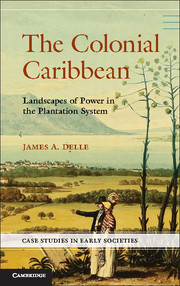Book contents
- Frontmatter
- Contents
- Figures
- Tables
- Preface
- 1 Landscapes of Power in the Colonial Caribbean
- 2 His Majesty’s Island
- 3 The Plantation Mode of Production
- 4 A Class for Itself: Regional Landscapes of the Planter Class
- 5 Contradictions and Dialectics: Village Landscapes of the Enslaved
- 6 Dialectics and Social Change: Plantation Landscapes after Slavery
- 7 Plantation Landscapes in Comparative Perspective
- 8 Conclusion
- References
- Index
1 - Landscapes of Power in the Colonial Caribbean
Published online by Cambridge University Press: 05 June 2014
- Frontmatter
- Contents
- Figures
- Tables
- Preface
- 1 Landscapes of Power in the Colonial Caribbean
- 2 His Majesty’s Island
- 3 The Plantation Mode of Production
- 4 A Class for Itself: Regional Landscapes of the Planter Class
- 5 Contradictions and Dialectics: Village Landscapes of the Enslaved
- 6 Dialectics and Social Change: Plantation Landscapes after Slavery
- 7 Plantation Landscapes in Comparative Perspective
- 8 Conclusion
- References
- Index
Summary
On the morning of May 23, 1832, Samuel Sharpe was hanged in the Jamaican town of Montego Bay. The hanging of black men was a tragically common event in the colonial Caribbean, and this particular execution may well have slipped unnoticed into the annals of history had it not been for the fact that Sam Sharpe was the condemned leader of an uprising of Jamaica’s enslaved population. Although insurrections of the enslaved working class were common in colonial Jamaica, the scale of this particular event was unprecedented in British West Indian history. The insurrection led by Sharpe, known alternately as the Baptist War, the Christmas Rebellion, and the Great Slave Rebellion, involved tens of thousands of people who took up arms, not against the planters who enslaved them, but against the sugarcane fields and industrial buildings in which they worked. During the two-week period between December 27, 1831 and January 5, 1832, some 100 plantations in the western parishes of Jamaica were destroyed; yet only about 17 white people were killed. The uprising was quickly suppressed by the well-armed Jamaica militia, and reprisals against the rebels were swift and brutal, resulting in more than 300 executions, including that of Sam Sharpe (Blackburn 1988; Hart 2002; Holt 1992; Reckford 1968; Watts 1990).
- Type
- Chapter
- Information
- The Colonial CaribbeanLandscapes of Power in Jamaica's Plantation System, pp. 1 - 21Publisher: Cambridge University PressPrint publication year: 2014

